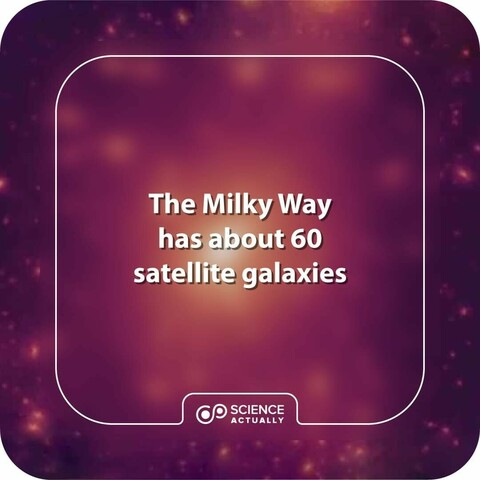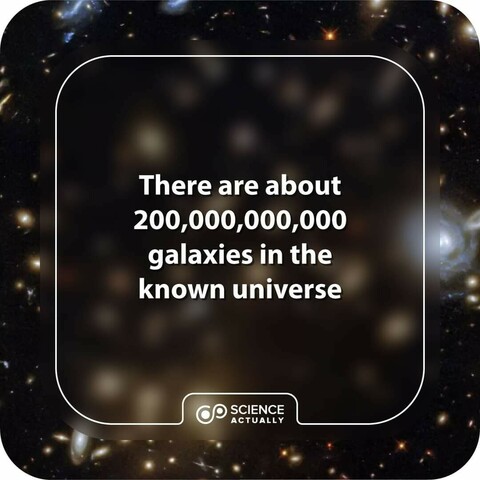Norobiik · @Norobiik
210 followers · 3329 posts · Server noc.social"Existing models suggest that after a period of rapid expansion, the universe spent a few hundred million years cooling down enough for gas to coalesce and collapse into the first stars and galaxies began to form, a period known as the dark ages."
#JamesWebbTelescope detects evidence of ancient ‘universe breaker’ #galaxies | #Astronomy #Universe | The Guardian
https://www.theguardian.com/science/2023/feb/22/universe-breakers-james-webb-telescope-detects-six-ancient-galaxies
#Universe #astronomy #Galaxies #JamesWebbTelescope
ScienceActually · @scienceactually
14 followers · 36 posts · Server sfba.socialThe Milky Way has about 60 satellite galaxies - including the notable Large Magellanic Cloud, which can be observed with the naked eye - although studies predict that our home galaxy should host an additional 100 or so very faint satellite galaxies we've not found yet.
#science #sciencefacts #milkyway #galaxy #galaxies #satellitegalaxies
#science #sciencefacts #milkyway #galaxy #Galaxies #satellitegalaxies
ScienceActually · @scienceactually
12 followers · 28 posts · Server sfba.socialThere are about 200,000,000,000 galaxies in the known universe.
#science #sciencefacts #galaxies #universe #knownuniverse #observableuniverse
https://www.space.com/25303-how-many-galaxies-are-in-the-universe.html
#science #sciencefacts #Galaxies #universe #knownuniverse #observableuniverse
Jcmacomber · @jcmacomber
1604 followers · 2619 posts · Server mastodon.onlineFrederik De Wilde · @StudioDW
0 followers · 17 posts · Server mastodon.onlineSwipe through the universe with pinpoint accuracy and sweeping beauty!
The interactive map, which depicts the actual position and real colors of 200,000 galaxies, is available online, where it can also be downloaded for free.
#beauty #map #galaxies #johnhopkins #interactiveexperience #cosmology #mastosocial #interactive
#interactive #mastosocial #cosmology #interactiveexperience #JohnHopkins #Galaxies #Map #beauty
soya · @soya
95 followers · 1010 posts · Server nebbia.fail"Queste osservazioni sono rivoluzionarie: si è aperto un nuovo capitolo dell’astronomia», commenta Paola Santini, ricercatrice Inaf a Roma e coautrice del nuovo articolo. «Già dopo i primissimi giorni dall’inizio della raccolta dati, Jwst ha mostrato di essere in grado di svelare sorgenti astrofisiche in epoche ancora inesplorate»
#jwst #galaxies
https://www.media.inaf.it/2022/11/17/jwst-galassie-primordiali/
AEROSPATIAL · @aerospatial
8 followers · 68 posts · Server mastodon.online#GALAXIES || Scientists discover massive '#extragalactic structure' behind the #MilkyWay ||By B. Specktor / #LiveScience || https://www.livescience.com/zone-of-avoidance-giant-structure || Spotted by #AEROSPATIAL ||
#aerospatial #livescience #milkyway #extragalactic #Galaxies
Dr Robert Minchin · @Robminchin
676 followers · 351 posts · Server mastodon.online#ResearchIntroduction 2/2:
What drives my interest in these surveys is the effect of the environment on #galaxies. I've been working this on since my #MSci #dissertation on "The cores of galaxies in the Coma cluster", and it is explicit in the full name of AGES – the #Arecibo #Galaxy Environment Survey. WAVES, the other survey I led, covers the Virgo cluster (the 'V' in WAVES). I've also investigated environmental effects at other wavelengths, such as ionised carbon in Virgo in a recent paper
#galaxy #arecibo #dissertation #MSCI #Galaxies #researchintroduction
AEROSPATIAL · @aerospatial
8 followers · 68 posts · Server mastodon.online#SPACE #SCIENCES || The mystery of X #galaxies || With their remarkable shape and rarity, cross-shaped galaxies are intriguing. Researchers believe they finally know how they are formed: by the #rotation of the supermassive #blackhole at their centre. | V. Faivre | https://www.science-et-vie.com/article-magazine/le-mystere-des-galaxies-x-est-resolu
#blackhole #rotation #Galaxies #sciences #space
Scott Trager · @SCTrager
138 followers · 25 posts · Server mastodon.online#introduction
I'm an #astrophysicist at the #Kapteyn Astronomical Institute at the #UniversityOfGroningen in the Netherlands. I study the most massive #galaxies in the Universe and build #AstronomicalInstrumentation to observe them. I'm originally American but have lived in the #NL for more than 20 years now.
I love music, play guitar badly for nearly 40 years, and am an avid board and #TTRPG gamer. I have a deep fondness for comic books and strategy games. #astrodon #astronomy
#ttrpg #astronomy #Astrodon #nl #astronomicalinstrumentation #Galaxies #UniversityOfGroningen #kapteyn #Astrophysicist #introduction
Gustavo · @astromecanik
209 followers · 536 posts · Server mastodon.onlineMy latest image shows an interesting grouping of #galaxies in the constellation Pegasus. The bigger one at right is NGC 7331, around 40 million light-years away. More interesting, though, is the smaller group at lower left, known as Stephan's Quintet. 4 of these 5 galaxies (distance 210–340 MLy) are actually very close to each other, and possibly will merge together; the fifth one just happens to be in the same relative location from our perspective but it's a lot closer (~39 Mly).
FediFollows · @FediFollows
42458 followers · 2128 posts · Server mastodon.onlineJason Nishiyama is a university professor and research astronomer who posts about stars, related phenomena and the telescopes used to observe them. You can follow at:
Nishiyama is the author of "An Introduction to Planetary Nebulae", 2018 ( https://www.morganclaypoolpublishers.com/catalog_Orig/product_info.php?products_id=1249 ).
#JasonNishiyama #Astronomy #Astronomer #Astronomers #Star #Stars #Planets #Galaxies #Telescope #Telescopes #Stellar #Astro #Photography #Science #Scientist #Scientists #Scientific #AstroPhotography #Academic
#academic #astrophotography #scientific #Scientists #scientist #science #photography #astro #stellar #Telescopes #telescope #Galaxies #planets #stars #star #astronomers #Astronomer #astronomy #JasonNishiyama
FediFollows · @FediFollows
42461 followers · 2128 posts · Server mastodon.onlineTino Heuberger is an astrophotographer who posts amazing photos of the night sky. You can follow at:
Website is at https://theuberger.ch
(This account was recommended to me, please DM or @ me if you would like to suggest an account!)
#TinoHeuberger #AstroPhotography #Astronomy #Stars #Galaxies #Nebulae #Nebula #Photography #Photos
#photos #photography #nebula #nebulae #Galaxies #stars #astronomy #astrophotography #TinoHeuberger
FediFollows · @FediFollows
42461 followers · 2128 posts · Server mastodon.onlineJason Nishiyama is an astronomer who posts about stars, planets, galaxies and the equipment used to observe them. You can follow at:
#JasonNishiyama #Astronomy #Astronomer #Stars #Planets #Galaxies #Telescopes #Stellar #Photography
#photography #stellar #Telescopes #Galaxies #planets #stars #Astronomer #astronomy #JasonNishiyama








